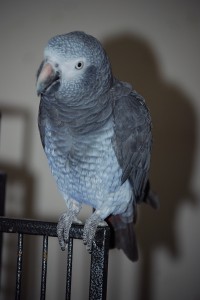Solving Problem Parrot Screaming
NOTE: I have a new pet behavior blog located at http://www.SoMuchPETential.com/blog. Thanks!
(a past Hyde Park Living column)
Screaming is one of those behaviors many bird owners complain about because they can’t seem to get the behavior to stop. And let’s face it…that noise isn’t exactly pleasant – at least to most of us.
Eleven years ago I was among the statistic of those who blamed Barnaby for making a noise I couldn’t live with. Just like so many other bird owners, I tried everything I had heard to try. I tried putting him in his cage, talking to him in quiet words, telling him “no”, ignoring him. All to no avail. I was at the end of my rope when I stumbled upon Susan Friedman, Ph.D. and her behavior teachings. Not only has my whole relationship with my pets changed as a result, she has sparked this passion in me to educate  others about using positive, scientifically proven strategies for modifying behavior.
others about using positive, scientifically proven strategies for modifying behavior.
What Susan teaches is that we’ve got to stop looking for answers by labeling behaviors or birds, or species generalities. It serves no purpose in helping to get at the root of the problem. The bottom line is that ALL behavior has function. No matter what the behavior is – whether it’s biting, not stepping up, chewing on furniture, or screaming – something occurred immediately prior to the act (antecedent) that may serve to “lead to” it, and something occurred immediately after the act (consequence) that impacts whether or not the behavior will be repeated in the future.
We, as teachers, can influence behaviors by changing the environment including antecedents and consequences.
All of my earlier attempts, I was taught, were actually reinforcing his screams – definitely why he had never stopped screaming. There’s a scientific word for what I had been doing. It’s called “intermittent reinforcement”, meaning, sometimes I gave him attention for screaming without even realizing it. Intermittent reinforcement make a behavior more resistant to change (think of the addiction of the slot machine in a casino).
My challenge as Barnaby’s teacher, was to provide him with a more stimulating and satisfying alternative to his screaming. In summary, it boiled down to three basic steps –
1) Ignore all screaming. Period. No attention at all, if I’m in the room, I calmly walked out with the other birds. With this step, I had to be prepared for an “extinction burst” where he screamed even louder to try to get my attention. Under no circumstances could I give in and go to him during this, or his problem would only worsen. The contingency I wanted Barnaby to learn was, “When” I scream “Then” the room is evacuated.
2) DRA or differential reinforcement of an alternative behavior. Each and every time Barnaby would make a chosen sound (at first it was a whistle, then changed it to “mommy here”), I was immediately there with reinforcement. The contingency I wanted Barnaby to learn with this was “When” I make this sound “Then” mom gives me attention. Eventually I got to where I don’t come each time, sometimes I’ll tell him I’m busy.
3) Thoughtful arrangement of the environment. I needed to make sure Barnaby had enough activities that HE was interested in to keep him busy. When I left his room, in the beginning, I would give him something to keep his mind occupied until I was out of sight. If he wasn’t interested in what I had given him, it meant that his gift wasn’t as stimulating to him as calling out to me, and so I had to find something else that was.
It has now been ten years since I first started learning about this. And I’ve got quite a little chatter box in my home. People ask me why Barnaby talks so much and I tell them it is because he gets attention when he talks. When he screams he gets no attention.
Of course there are still moments when the birds scream, they are, after all birds. But it is more the exception than the rule now.















